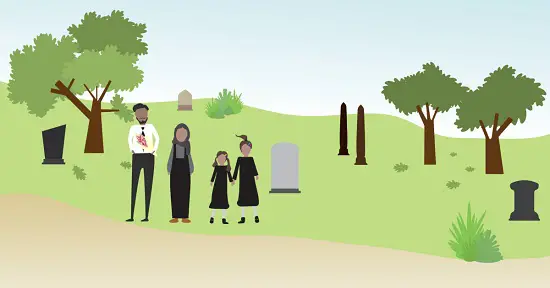| Most people in North America die either in hospital or at home. |
| When someone dies, arrangements are made with a funeral home to get the body and prepare it for burial. |
| Funeral homes are private businesses. |
| They usually handle most or all aspects of a funeral, except for providing the burial plot. |
| That usually has to be purchased separately. |
| Funeral homes may operate in many kinds of buildings. |
| Old roomy private homes and new modern one-level buildings are common types. |
| When the funeral director receives the body, his staff embalms it |
| so it will not decay quickly and will look lifelike at the funeral service. |
| For one or two days before the burial, |
| friends, relatives and acquaintances are invited to visit the funeral home |
| and pay their respects to the dead person. |
| The deceased person is usually dressed in their best clothes, and lying on their back in a coffin. |
| A coffin is a large wooden or metal chest designed to hold the body. |
| Members of the dead person’s immediate family usually act as hosts for the funeral home visitation. |
| They greet the mourners and talk to them about the deceased. |
| Usually, there are happy photographs of the dead person near the coffin. |
| Gifts of flowers also surround the coffin. |
| Usually the mourners are asked to sign a guest book. |
| The funeral service may take place at a church, if the deceased person wanted that. |
| Frequently, however, the service is held at a chapel at the funeral home. |
| Attending a funeral is considered a sign of respect, and people will often travel a long distance to attend. |
| Usually friends and relatives will take a day off work for the occasion. |
| Notices are put in the newspaper for several days before, so that people will know when to come. |
| A minister or priest usually conducts the funeral service. |
| There will be hymns, prayers, and perhaps a sermon, like a regular church service. |
| Sometimes, the minister will speak at length about the dead person. |
| Sometimes, a member of the family does this. |
| Opportunity is allowed for other people to talk about their memories of the dead person. |
| At the end of the service, the coffin is wheeled out to a waiting car, called a hearse, |
| which drives the dead person to the burial place. |
| The mourners go to their cars and follow the hearse to the cemetery. |
| At the cemetery, a hole has already been dug to receive the coffin. |
| Usually there’s a short ceremony at the grave. |
| Sometimes, flowers are put on top of the coffin as it is lowered into the grave. |
| A handful of soil is tossed on the coffin, indicating burial. |
| Usually the mourners leave before the cemetery workers cover the coffin with earth. |
| Then the mourners may go back to a church hall or restaurant for a meal. |
| A funeral can be quite costly. |
| Even an inexpensive coffin can be several thousand dollars. |
| Sometimes, the deceased will be placed in an expensive rental coffin for the visitation and funeral, |
| but buried in a less expensive coffin. |
| Even so, a full funeral rarely costs less than $5,000, and is usually quite a lot more. |
| This does not include the price of the burial plot or the stone grave marker. |
| Sometimes poor people are buried at government expense. |
| It is traditional in North America to bury the whole body in the ground. |
| However, cremation is becoming more popular. |
| The advantage of cremation is that it is less expensive, uses less land, |
| and it appeals to people who don’t want an elaborate funeral. |
| Some people may wonder why so much attention is paid to a dead person. |
| But funerals are really for the living. |
| They are a way of saying goodbye to the dead person |
| and receiving mutual support and encouragement from friends and family. |
| Some funeral homes help to organize grief counselling or support groups to grieving family members. |
| Usually the funeral service is performed in the Christian tradition |
| and refers to the hope of resurrection or rebirth from the dead that Christians believe in. |
| It is now becoming common for people to plan their own funeral service before they die. |
| And usually attempts are made to make the service appropriate to the person who died. |
| This makes it more satisfying and memorable for family and friends. |





